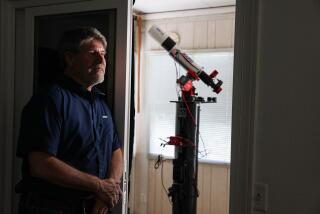Scientists Hope Tiny Ripples in Space Will Unlock Big Secrets
- Share via
RICHLAND, Wash. — This summer, two observatories in the United States begin their search for gravitational waves from outer space, looking for evidence of black holes, neutron stars and supernovas.
Or maybe even remnants of the Big Bang, the great cosmic explosion that might have given birth to the universe 15 billion years ago.
“It’s a new window on the universe,” said Beverly Berger, program director for gravitational physics at the National Science Foundation in Arlington, Va.
“In the past, whenever astronomers have opened a new window, they’ve seen something unexpected.”
Cosmic cataclysms are believed to produce ripples--gravitational waves--that travel at the speed of light in the fabric of space and time, but so far no one’s seen them.
The effect researchers are looking for is similar to that of a rock being dropped into water, with the ripples diminishing in size the farther they get from the spot where the rock fell.
It’s essentially an emerging area of physics and astronomy, but it builds on a nearly century-old idea: Albert Einstein predicted the existence of gravitational waves with his general theory of relativity in 1916.
Almost a century later, scientists believe the precision technology finally exists to find them.
“We’re looking for very violent events where space gets disrupted,” said physicist Fred Raab, director of the Laser Interferometer Gravitational Wave Observatory (LIGO) at Hanford nuclear reservation in south-central Washington.
LIGO Hanford works in tandem with LIGO Livingston, 1,877 miles away, at a site just east of Baton Rouge, La.
Raab compares LIGO to a big microphone “listening” for gravitational waves with equipment that can convert those waves to audible signals.
While researchers are reasonably certain that the waves exist, they don’t know if the LIGO detector will be able to see them, Raab said.
Sometime this summer, they’ll turn on the lasers and wait.
Scientists believe that the initial system might detect waves, Raab said, and a more advanced system, which could be up and running by 2008, should detect them.
The cosmic explosions--collisions of black holes or the blasts of a supernova--happen hundreds of millions of light-years away, so the gravitational waves would be extremely faint.
“They don’t happen nearby typically, which is a good thing, because it would destroy us,” Raab said.
Black holes are collapsed stars so dense that not even light can escape their gravity.
Much larger supermassive black holes are believed to occupy the centers of galaxies, where they swallow hundreds of thousands of stars.
“LIGO gives us information that we don’t have access to any other way, things like black holes, things we can only infer from the light we see,” Berger said.
Here in the sagebrush desert, the interferometer is made up of a pair of 2.5-mile-long vacuum tubes that jut at right angles from a central building where a laser bounces light off specially designed mirrors that will help catch and reflect the minute vibrations of gravitational waves.
The waves are so small they are expected to move the mirrors by one-thousandth of a fermi, a measurement less than a trillionth of the diameter of a human hair.
The two observatories were built to work together, a means of confirming gravitational waves amid the vibrational noise of the Earth.
It is less likely that two sites separated by almost 2,000 miles would detect false signals at the same time.
Other interferometers are being constructed in Europe and one is operating in Japan.
The 13-year-old LIGO project has cost $372 million so far and is funded by the National Science Foundation.
It is operated by Caltech and MIT.





